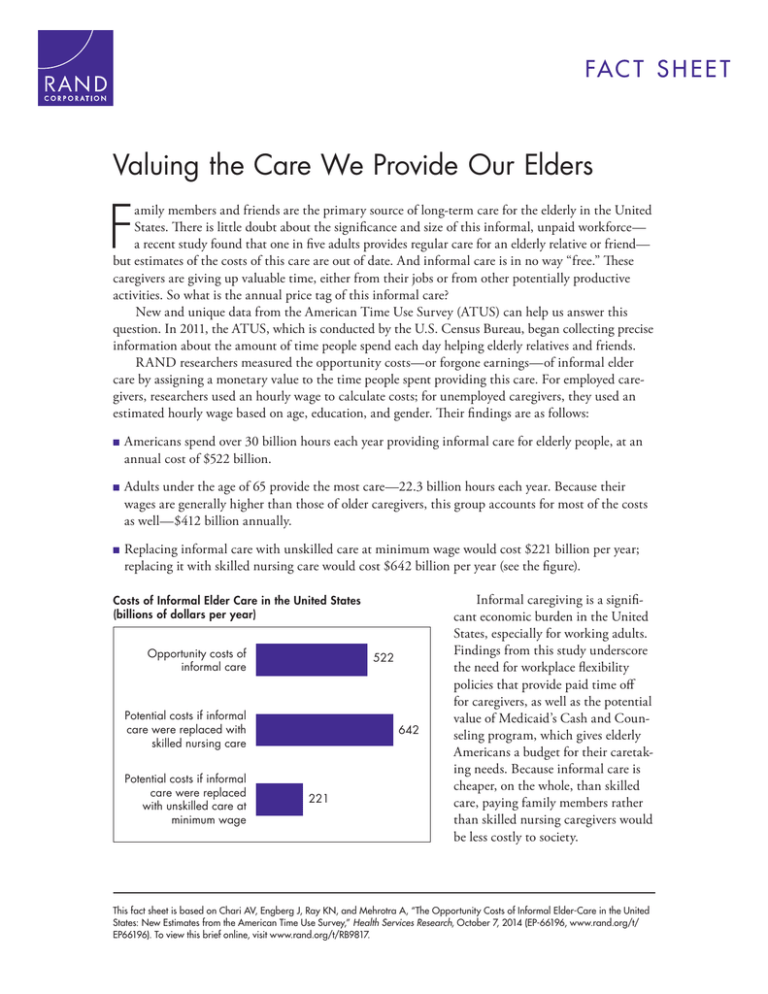F Valuing the Care We Provide Our Elders
advertisement

FAC T S H E E T C O R P O R AT I O N Valuing the Care We Provide Our Elders F amily members and friends are the primary source of long-term care for the elderly in the United States. There is little doubt about the significance and size of this informal, unpaid workforce— a recent study found that one in five adults provides regular care for an elderly relative or friend— but estimates of the costs of this care are out of date. And informal care is in no way “free.” These caregivers are giving up valuable time, either from their jobs or from other potentially productive activities. So what is the annual price tag of this informal care? New and unique data from the American Time Use Survey (ATUS) can help us answer this question. In 2011, the ATUS, which is conducted by the U.S. Census Bureau, began collecting precise information about the amount of time people spend each day helping elderly relatives and friends. RAND researchers measured the opportunity costs—or forgone earnings—of informal elder care by assigning a monetary value to the time people spent providing this care. For employed caregivers, researchers used an hourly wage to calculate costs; for unemployed caregivers, they used an estimated hourly wage based on age, education, and gender. Their findings are as follows: ■Americans spend over 30 billion hours each year providing informal care for elderly people, at an annual cost of $522 billion. ■Adults under the age of 65 provide the most care—22.3 billion hours each year. Because their wages are generally higher than those of older caregivers, this group accounts for most of the costs as well—$412 billion annually. ■Replacing informal care with unskilled care at minimum wage would cost $221 billion per year; replacing it with skilled nursing care would cost $642 billion per year (see the figure). Costs of Informal Elder Care in the United States (billions of dollars per year) Opportunity costs of informal care 522 Potential costs if informal care were replaced with skilled nursing care Potential costs if informal care were replaced with unskilled care at minimum wage 642 221 Informal caregiving is a significant economic burden in the United States, especially for working adults. Findings from this study underscore the need for workplace flexibility policies that provide paid time off for caregivers, as well as the potential value of Medicaid’s Cash and Counseling program, which gives elderly Americans a budget for their caretaking needs. Because informal care is cheaper, on the whole, than skilled care, paying family members rather than skilled nursing caregivers would be less costly to society. This fact sheet is based on Chari AV, Engberg J, Ray KN, and Mehrotra A, “The Opportunity Costs of Informal Elder-Care in the United States: New Estimates from the American Time Use Survey,” Health Services Research, October 7, 2014 (EP-66196, www.rand.org/t/ EP66196). To view this brief online, visit www.rand.org/t/RB9817. The RAND Corporation is a research organization that develops solutions to public policy challenges to help make communities throughout the world safer and more secure, healthier and more prosperous. RAND is nonprofit, nonpartisan, and committed to the public interest. RAND’s publications do not necessarily reflect the opinions of its research clients and sponsors. R® is a registered trademark. Limited Print and Electronic Distribution Rights: This document and trademark(s) contained herein are protected by law. This representation of RAND intellectual property is provided for noncommercial use only. Unauthorized posting of this publication online is prohibited. Permission is given to duplicate this document for personal use only, as long as it is unaltered and complete. Permission is required from RAND to reproduce, or reuse in another form, any of our research documents for commercial use. For information on reprint and linking permissions, please visit www.rand.org/pubs/permissions.html. www.rand.org © RAND 2015 RB-9817 (2015)




